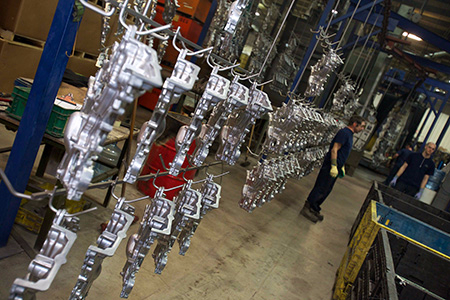Shot peening is a widely used method in the realm of materials engineering and manufacturing to enhance the strength and durability of metal components. This process involves bombarding a metal surface with small, round particles, typically shot media such as steel, ceramic, or glass beads, using specialized equipment like air-driven turbines or centrifugal wheels. The impact of these particles induces beneficial residual stresses in the surface layers of the metal, resulting in improved mechanical properties.

The primary mechanism behind shot peening lies in the introduction of compressive residual stresses and the creation of a more uniform surface. As the shots strike the metal surface, they create numerous indentations or dimples. These indentations plastically deform the surface, inducing compressive stresses while simultaneously work-hardening the affected layer. This process alters the surface microstructure, increasing its resistance to fatigue, stress corrosion cracking, and other forms of material degradation.
The compressive residual stresses formed during shot peening act as a barrier against crack initiation and propagation. By countering the tensile stresses that naturally occur during material processing or use, shot peening helps to minimize the potential for crack formation. Consequently, the component's fatigue life is significantly extended, making it more reliable under cyclic loading conditions.
Furthermore, shot peening alters the material's surface morphology, smoothing out irregularities and removing micro-defects. This results in a more uniform and refined surface finish. The process can also induce strain hardening, which increases the material's strength and hardness.
The effectiveness of shot peening depends on various parameters, including the type and size of the shot media, peening intensity, coverage, and the material being treated. The choice of shot material and size is crucial as it determines the energy transfer and the depth of the compressive layer. Ceramic shots, for instance, provide deeper compressive layers compared to steel shots due to their higher density and hardness.
Peening intensity, typically measured by parameters like Almen intensity, determines the energy imparted to the surface. Monitoring and controlling this intensity are critical to achieving the desired residual stress profiles without causing surface damage or overworking the material.
Full coverage during shot peening ensures uniform properties across the entire surface. However, it's essential to balance coverage with the risk of overworking or potentially damaging the material, especially in complex geometries or areas with restricted accessibility.
Despite its numerous advantages, shot peening has its limitations and considerations. One such consideration is the potential for hydrogen embrittlement, particularly in high-strength steels. The process can introduce hydrogen into the material, which may cause cracking and reduce the material's ductility. Proper post-peening treatments or material selection can mitigate this risk.
In summary, shot peening is a versatile and effective method for strengthening metals by inducing compressive residual stresses, improving surface finish, and enhancing fatigue resistance. Its application spans various industries, including automotive, aerospace, and manufacturing, where components are subjected to high cyclic loads or harsh operating conditions. By understanding and optimizing the parameters involved, shot peening remains a valuable technique for enhancing the performance and longevity of metal components.

